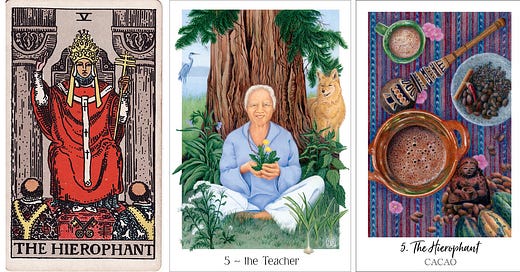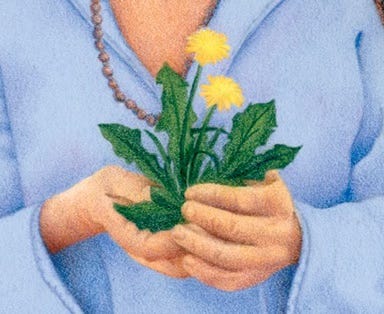Hierophant ~ Reveal the Mysteries: “Have Mercy”
A Journey through the Tarot Major Arcana: The Hierophant ~ Card 5

A note for all those who pre-ordered the new edition of the Gaian Tarot: I just found out that the original publication date of late February has been pushed back to April 28th. Deep appreciation to all of you who pre-ordered, as pre-orders are vital to authors and publishers. Thank you! If you haven’t yet heard about the new edition, you can read more about it here, and pre-order here.
Thanks for joining me on my quest to renew my tarot practice by taking a journey through the cards of the Major Arcana. This is the sixth post in the series, which is an offering for paid subscribers. We focus mainly on the Gaian Tarot and the Herbcrafter’s Tarot in this series, which includes a look at the card’s themes, card comparisons, creative sparks and crafts, journal prompts, and even a playlist inspired by the card. These posts are longer than most of mine. Thanks for reading. I’d love to hear your responses in the comments.
“My religion is very simple. My religion is kindness.”
- Tenzin Gyatso, the 14th Dalai Lama, spiritual leader of Tibetan Buddhism
“Have mercy.”
— Bishop Mariann Edgar Budde, Episcopal Diocese of Washington, D.C., speaking at the Washington National Cathedral during a prayer service attended by the new president and his allies on January 21, 2025.
Like the Emperor card, the Hierophant is one of those problematic cards that causes discomfort for many people. At first glance, it depicts an oppressive religious system.
Originally called “The Pope,” it signifies religious authority and tradition, especially the outer levels of doctrine and orthodoxy. Unlike the High Priestess, who is always shown alone, the Pope or Hierophant is accompanied by acolytes who bow before him. There’s an immediate sense of hierarchy and “power-over” in historical versions of the card. Many of us who fled toxic religions or high-control groups are triggered by the imagery.
Happily, it’s one of the cards that has been most often reinterpreted by tarot deck creators in the Tarot Renaissance of the past 40+ years. The name of the card was changed from “Pope” to “Hierophant” in the 18th century. This title refers to the high priest of the Eleusinian Mysteries in ancient Greece. In her book Tarot Wisdom, Rachel Pollack writes that the word hierophant means “he who shows the sacred.” In her experience, mystical experiences, and direct connection to the Divine, often arise within the context of a person’s religious or spiritual heritage. She changed the name of this card to “Tradition” in her Shining Tribe Tarot.
John and Caitlín Matthews also renamed this card “Tradition” in the Arthurian / Hallowquest Tarot, which I studied in depth in the 1990s. The figure on it is the bard Taliesin, keeper of an oral tradition in which teachings and lore were passed on from generation to generation.
My negative sense of the card began to shift because of the Arthurian and Shining Tribe Tarots. I was able to start positively reframing the card, thinking of it as representing valuable cultural and spiritual teachings that are passed down through a lineage of teachers.
Another turning point came when I studied the Eleusinian Mysteries in depth. The Hierophant, on the last day of the lengthy rituals, revealed a sheaf of grain to the initiates in silence. It was said that in that moment, many lost their fear of death. We know only a few tantalizing details about what happened in those rituals, but we do know that “Hierophant” can be translated as “Revealer of the Mysteries.” I no longer remember what book provided that information. But I do remember its profound impact on me.
“Revealer of the Mysteries”! That completely changed my relationship with this card.
A “revealer of the mysteries” is a long way from an authoritarian religious leader who wants to rigidly enforce doctrine and rules in order to maintain power over their followers. I began to see the Hierophant card as more double-sided than most. Every tarot card carries a continuum of meanings from positive to negative, or inspirational to challenging. The Hierophant and Emperor are two cards whose varied meanings are more extreme than most.
For me, the Rider-Waite-Smith card (and others modeled on it) shows the shadow side of the card — the negative authoritarian side of it, even in an upright position. I began to seek out decks that showed a more positive take on religious/spiritual teachers. When the time came to create my own decks, I took great delight in portraying images of life-giving spiritual teachers. (More on the Gaian, Pentimento, and Herbcrafter’s Hierophant cards below.)
My friend Lauren alerted a few of us to a video making the rounds last week, of a woman bishop speaking truth to power as she preached directly to the newly inaugurated president from her pulpit. (Thanks, Lauren!) You’ve probably seen the video by now. “Have mercy, Mr. President,” she said. “I ask you to have mercy upon the people in our country who are scared now.”
Bishop Mariann Edgar Budde is a shining embodiment of the whole, healthy, life-sustaining side of the Hierophant archetype.
“Have mercy.”








